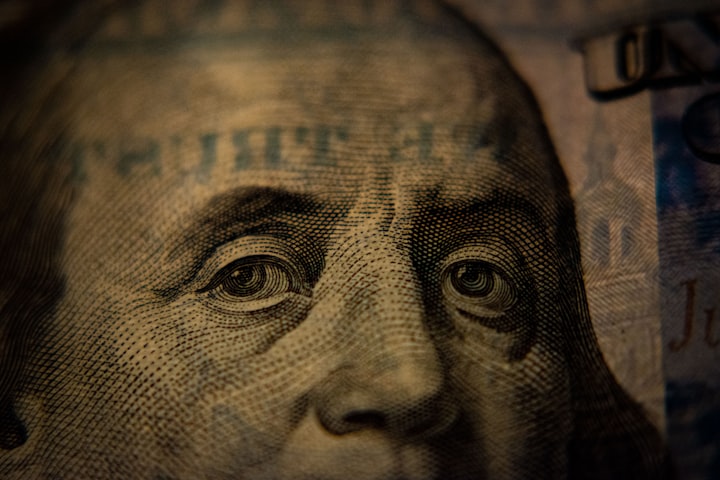How US Dollar Gets So Powerful
Why the US Dollar Became the World Reserve Currency
The US Dollar is the most widely used currency for international trade and other transactions around the globe.
A reserve currency is a foreign currency that a central bank or treasury holds for the country’s foreign exchange reserves.

Countries keep foreign exchange reserves for managing economic crises, paying for imports, intervening in foreign exchange markets, or servicing their debt denominated in foreign currency.
Most global central banks' reserves are held in US dollars, which de facto makes dollars the global reserve currency.
According to the IMF, 59% of foreign exchange reserves held by central banks are in US dollars, While the euro only makes up 21% of foreign exchange reserves.

In Global foreign exchange markets, The US Dollar is involved in nearly 90% of all transactions.
In the 21st century, No currency has been able to come close to threatening the US dollar's dominance in the global economy.
For the United States, dollar global dominance has provided many benefits to the US economy, such as paying low interest on government debt because of high demand from Global central banks and investors, which allows the US government to borrow cheaply.

US dollar dominance also gives America strategic financial power, which they can use to sanction any country, which could cripply their economies, ie, Russia or Iran.
However, the high demand for US dollars globally also has some disadvantages for American exporting companies, which can make their export more expensive relative to competition in the global economy.
It also costs Americans some lower-paying jobs to move from their country to poorer countries, where wages are low.
Firms have to pay higher wages in US dollars, Which can be more costly than paying workers in low-income countries such as India with rupees or Vietnam with Vietnamese dong than in the United States with its strong dollar.
Most central banks hold dollars in the form of US treasury bills. The US Treasury market is the most liquid in the world, which allows central banks to sell and buy US government bonds.

Most valuable commodities like oil and gas are bought and sold with US dollars, Which makes it crucial for countries to hold US dollars to buy oil and gas in the global market, which is valuable for every country's economy.
Most international transactions are done with the mighty US dollars. For example, if Japan wants to buy oil and gas from Saudi Arabia.

Japan will buy that oil and gas with the payment denominated in the US dollar because Saudi Arabia and many oil-rich nations trust the US dollar more than their foreign partners' home currency, which might devalue in the future.
40% of the world's debt is issued in US dollars, which makes it crucial for foreign banks to hold a large quantity of US dollars to conduct business. It was evident during the 2008 financial crisis. Non-US banks held 27 trillion in international liabilities, almost 18 trillion of that liability denominated in US dollars.

As a result, the US Federal Reserve had to increase its dollar swap lines to foreign banks to stop the world from running out of US dollars.
So why is the dollar so dominant and trustworthy around the world?
Rise of the Greenback
For a long time, Developed economies linked their currency to gold.
But after World War One, many countries, including the UK, Which was the dominant power at the time. Ditch the gold standard to print paper money to finance their military expenditure.

Eventually, the US dollar, still tied to gold, overtook the British pound to become the world reserve currency.
Most people started trusting the US dollar more than the paper British pound because it was backed by gold which restricts the supply of money to its gold reserves, thus not causing high inflation, which erodes the value of money.
Bretton Woods Agreement
During World War Two, the United States was a key supplier of war equipment for many European nations.
Many countries bought war tanks and fighter jets from the US and made their payment in gold.

This led to America having 70℅ of the world's gold reserves, leaving many nations disadvantaged.
In 1944, The 44 countries met at Bretton Woods, New Hampshire, and decided to peg their currency to the US dollar, Which was linked to gold at 35$ per ounce.

One of the reasons for pegging their currency to the US dollar was that America held the largest gold reserve in the world.
The Bretton Woods agreement allowed countries to peg their currencies with US dollars rather than gold; it was a major reason that led to dollar dominance in the global economy.
Many nations were satisfied to peg their currencies to the US dollar because it was directly pegged to gold.
The US government can't print new money out of thin air. Instead, it had to build its gold reserves to back new US dollars.

It made the US dollar a relatively stable currency, which was one of the reasons many central banks started building their dollar reserve.
Abandoning the Gold Standard

Over the decades, As central banks started growing and diversifying their reserves, they started redeeming large amounts of dollars for gold.
By the 1960s, the United States did not have enough gold reserves to cover the dollar circulating outside the US, which led to fear of a run that could wipe out US gold reserves.
Following many failed attempts to save the system, President Richard Nixon suspended the convertibility of dollars into gold in August 1971. It marked the end of the Bretton Wood fixed exchange rate system and led to the market-determined exchange rate we have today.
Some countries continue to peg their currency to the US dollar, Such as Saudi Arabia, UAE, and Hong Kong, which has a positive economic impact, reducing exchange rate risk and increasing investment in their economy.
Most US investors want to diversify their investment into other countries, and they particularly get attracted to countries that are pegged to the US dollar because big US firms and investors don't have to worry about the market exchange rate going up and down and can invest in countries such as UAE more comfortably.
Despite abandoning the gold standard, the US dollar has remained a global reserve currency because, despite many challenges, The world still trusts the US financial system and its stable economy.
Why is the Swiss franc or Singaporean dollar, not the world reserve currency even though these countries are stable politically and economically?
These economies and their currency may be stable. But the US is by far the biggest military and economic power in the world, Which made international investors, businesses, and global central banks believe in the dollar.
Being the largest economy and military power played an important role in making the US dollar the world reserve currency.
Is the US Dollar in Danger?

America had also used its power as the global reserve currency to sanction many of its rivals and let their economy into dire crises.
For example, Iran and North Korea were sanctioned by the Trump administration, Which also included preventing them from doing international trade using the US dollar.
In 2022, Russia's invasion of Ukraine prompted a huge-scale sanction by the EU and the United States.
Russia held the world's fifth-largest foreign exchange reserve, with about 581 billion dollars in November 2023.

Russia held a majority of US dollar, Euro, and Gold in its foreign exchange reserves. At least half of its assets were frozen by the EU and US within their jurisdiction after the invasion of Ukraine.
Russia has continued to drop its exposure to the US dollar. It has also been selling its oil and gas using the Russian ruble Recently.

According to critics, This is a threat to the mighty dollar, the dominant currency for buying and selling oil or natural gas on the global market.
It would raise some concern over the US dollar's role as the global reserve currency as many countries have seen that America can freeze their reserves denominated in US dollars for political reasons, Which made it crucial for non-US allies to find alternatives to the dollar.
Conclusion
The US dollar is now a fiat currency, meaning its value is based only on the people's faith in the US government.
While it may sound risky, it gives the government more power to deal with economic crises, as it did in March 2020 by printing more money. as a response to the coronavirus pandemic, which shut down the whole economy.

In the medium term, despite its challenges, the Dollar will remain a favorable global reserve currency in which most central banks and international businesses want to hold their reserves and trade through dollars.
But in the long term, dollar dominance may be in danger because of sanctioning countries for political reasons.
Those countries may be in crisis because of US sanctions in the short term. But in the long run, they will adapt to the situation and may not depend on the US dollar for international trade.
Critics of the US dollar argue many countries are pulling their reserves from dollars to other alternative currencies such as the euro, swiss franc, or Chinese renminbi.
But currencies like the Chinese renminbi or euro have serious challenges to overcome to consider even viable options for a global reserve currency.

However, over time, the share of the US dollar dominance has been reduced in the global economy. At some point, it would get replaced by another currency, but not in our lifetime.
Despite trillions of dollars in debt and continuous large deficit spending, it is still considered a global reserve currency because there is no serious threat to mighty dollars, at least for now.
Continue Reading :
Why Germany is Europe's Superpower
How a Hedge Fund Manager Turns 27 MILLION Into 2.6 BILLION Dollars Within 30 DAYS.
About the Creator
Arsalan Haroon
Writer┃SEO Expert┃Investor







Comments
There are no comments for this story
Be the first to respond and start the conversation.